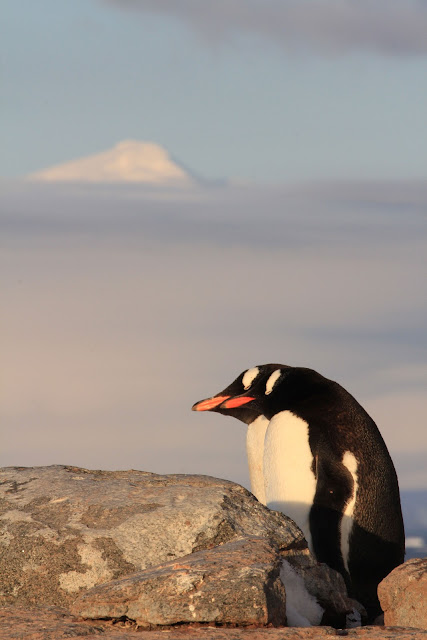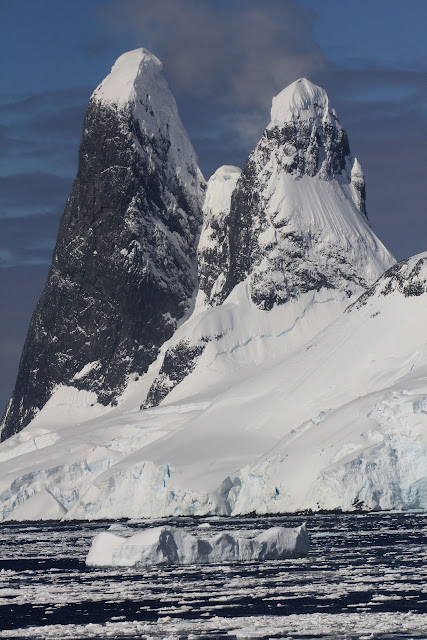Just when it seems like the previous best-day-ever can’t be
topped, it’s shoved aside by the 24 hours that just ended with my first ever
Antarctic sunset. The first jaw-dropping moment was as we cruised into Neko
Harbour, a sight unlike anything I’ve ever seen. The water looks like black
glass interrupted by icebergs, bergy bits, and brash ice. This is our first
absolutely still night and the temperature is cold enough that grease ice is
forming, creating a surface of something other than water or recognizable ice.
I stand on the bridge so mesmerized by the experience of viewing the water and
the craggy black rock and thick white glaciers rising steeply from the surface
that by the time I remember to run to my room and get a camera, the effect is
spoiled by the Zodiacs already in the water tracing rippled paths to the
landing site.
It’s time to gear up for an evening (8-10pm) Zodiac cruise
among the blue sculpted icebergs and seals hauled out on the ice. We drop off a
passenger on shore and a couple asks if they can jump out on the cobbled shore,
then jump back in for the cruise because this is our one and only continental
Antarctica landing – all of our other landings this entire month are on
islands. Because we’re anchored here for the night, I know I will set foot on
the continent during the next morning’s landing so I stay in the Zodiac. We
visit three icebergs. Two of them have Weddell Seals on them, occasionally
tipping their heads up, neck skin draping into Shar Pei-like folds while
oversize eyes peer at us. These are the most endearing of the three common seal
species we see everyday now. After we had our fill of the resting seals, we
headed over to a spaceship-shaped double iceberg with the purest blues and
greens illuminated by the evening light. We must have made a dozen passes at
slightly different angles and distances to get every possible shot before
working our way slowly back through the ice towards the ship. As we approach
the gangway, passengers on the Zodiac in front of us returning from a cruise
ask if they can first go to land quickly to set foot on the continent just in
case the weather takes a turn for the worse over night. We beg our Zodiac
driver to do the same, and since our driver is the owner of the company, the
always smiling and enthusiastic 74-year-old Doug Cheeseman, off we go to jump
ashore, snap pics of each other, and zip back for 5 hours of sleep before the
longest day of the trip, both in terms of daylight and activities planned.
The 530am wake-up call comes too early for all of us but few
miss the chance to explore the Gentoo Penguin colony spreading out up the
hillside. I’m not in the mood to photograph penguins this morning – I’d rather
watch their behavior for awhile without any concern for lighting, background,
and composition.
The cloudy morning breaks open to sunshine very slowly, to
the point where one of the passengers on his 9th trip to Antarctica
and I grumble about the new plan to stop outside the Lemaire Channel while we
eat lunch, then go through. We think the tentative sunshine will disappear so
we want to skip lunch altogether and go through the channel right now so we don’t miss anything. As usual, when Ted makes an
alteration to the day’s schedule, we have a much better experience. The
remaining clouds evaporate during lunch and we are treated to one of the most
spectacular views through the most sought-after passage in Antarctica. Everyone
has all of their gear on, shooting scenes from every possible angle. The
channel is quite narrow and multiple huge peaks rise directly above us, giving
the effect of being high in the Swiss Alps even though we’re at sea level. As
we continue south, the sea ice thickens into flat pancakes, with seals almost
always visible napping on them. The two species we see the most are Crabeater
Seals and Leopard Seals, with Leopards outnumbering Crabeaters (so named
because they eat krill – small crustaceans related to crabs). The Leopard Seals
also eat a lot of krill but they are famous for being stealthy predators of
penguins. They shake the penguin out of its skin leaving only the exterior of
the penguin and its neck vertebrae and skull. My friend commented that he could
tell resting Leopard Seals from Crabeater Seals because the Leopard Seals
always have bloody bits of meat on their ice beds. Up close, Leopard Seals have
a snake-like smile and large canines, but their premolars and molars are the
same tri-point formation as the Crabeater Seals’ teeth for sieving krill.
We reach the furthest point south of our trip at Petermann
Island, 65° 10’ S latitude, just outside the Antarctic Circle. We likely could
have made use of the icebreaker strength of our vessel to continue since the
sea ice completely covered the water’s surface, but instead we turned around
and made our way to the other side of Booth Island (which forms one half of the
Lemaire Channel’s walls).
After dinner, it was time for either a sunset Zodiac cruise
or a landing at a Gentoo and Chinstrap Penguin colony. I opted for the landing.
The late evening light and variety of penguins with chicks afforded great
viewing and photography. As we were being rounded up for the last boat back to
the ship at 11pm, I lingered to watch my first, and possibly last, Antarctic
sunset.
PS – no Lemaire Channel pictures for this posting because I
haven’t downloaded them yet! I’ve filled my laptop’s hard drive and only the
generosity of other passengers in lending memory cards and back-up space on
hard drives is guaranteeing space for my pictures. Of course this only delays
the heavy editing until later but I’d rather shoot now and edit during the
Drake Passage. I grossly underestimated how much memory I would go through and
I’m on the low side in comparison to others.







No comments:
Post a Comment